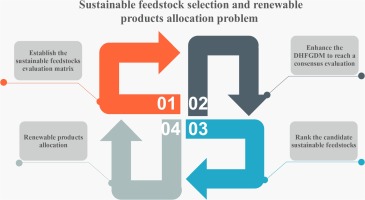当前位置:
X-MOL 学术
›
J. Environ. Manag.
›
论文详情
Our official English website, www.x-mol.net, welcomes your
feedback! (Note: you will need to create a separate account there.)
Sustainable feedstocks selection and renewable products allocation: A new hybrid adaptive utility-based consensus model.
Journal of Environmental Management ( IF 8.0 ) Pub Date : 2020-03-20 , DOI: 10.1016/j.jenvman.2020.110428 Hossein Gitinavard 1 , Mohsen Akbarpour Shirazi 1 , Mohammad Hossein Fazel Zarandi 1
Journal of Environmental Management ( IF 8.0 ) Pub Date : 2020-03-20 , DOI: 10.1016/j.jenvman.2020.110428 Hossein Gitinavard 1 , Mohsen Akbarpour Shirazi 1 , Mohammad Hossein Fazel Zarandi 1
Affiliation

|
Nowadays, preferred compromise response of renewable energies' demands regarding the candidate sustainable feedstocks is a crucial issue for market change management. Thus, selecting the most suitable sustainable feedstock is a key factor for optimum renewable products allocation problem. To address the issue, this study proposes a hybrid adaptive framework based on consensus evaluation approach, weighting and ranking procedure, and preferred demand assignment under dynamic hesitant fuzzy sets. In this respect, the consensus evaluation approach is tailored regarding the direct and indirect feedback mechanisms to enhance the quality evaluation of candidate sustainable feedstocks under assessment criteria. Thereby, the weight of each criterion is determined based on the developed dynamic hesitant fuzzy entropy method and the candidate sustainable feedstocks are ranked with respect to developed dynamic hesitant fuzzy positive and negative ideal solutions. Then, a revised multi-choice goal programming model is extended regarding the dynamic hesitant fuzzy closeness indexes to attend to preferred compromise response of demand centers by optimum renewable products allocation. Meanwhile, the presented hybrid adaptive framework is implemented to a real case study to represent the applicability and efficiency of the proposed approach. Furthermore, a comparative analysis is provided by defining eight comparison indexes to compare the obtained results with two recent studies in relevant literature for representing the validation and verification of the proposed approach. The comparative analysis shows that the proposed approach versus the two other approaches has merits such as modeling of uncertainty, experts' weights, adaptive structure, unanimous agreement-based approach, and last aggregation framework. Finally, a sensitivity analysis is represented to show the sensitiveness and robustness of the obtained results from changing the criteria weights, goals values, and consensus elimination. Thereby, the sensitivity analysis indicates that the obtained ranking results are sensitive to sustainability criteria unlike the technical criterion.
中文翻译:

可持续原料选择和可再生产品分配:基于混合效用的新型混合共识模型。
如今,可再生能源对候选可持续原料的需求的优先折衷响应是市场变化管理的关键问题。因此,选择最合适的可持续原料是优化可再生产品分配问题的关键因素。为了解决该问题,本研究提出了一种基于共识评估方法,加权和排名程序以及动态犹豫模糊集下的优先需求分配的混合自适应框架。在这方面,针对直接和间接反馈机制量身定制了共识评估方法,以根据评估标准加强对候选可持续原料的质量评估。从而,根据已开发的动态犹豫模糊熵方法确定每个准则的权重,并针对已开发的动态犹豫模糊正负理想解决方案对候选可持续原料进行排序。然后,针对动态犹豫模糊紧密度指标扩展了修订的多选目标规划模型,以通过优化可再生产品分配来应对需求中心的首选折衷响应。同时,将提出的混合自适应框架应用于实际案例研究,以表示所提出方法的适用性和效率。此外,通过定义八个比较指标来进行比较分析,以将获得的结果与相关文献中的两项最新研究进行比较,以代表所提出方法的验证和验证。比较分析表明,与其他两种方法相比,该方法具有不确定性建模,专家权重,自适应结构,基于一致协议的方法以及最后汇总框架等优点。最后,进行了敏感性分析,以显示通过更改标准权重,目标值和共识消除而获得的结果的敏感性和鲁棒性。因此,敏感性分析表明,与技术标准不同,所获得的排名结果对可持续性标准敏感。比较分析表明,与其他两种方法相比,该方法具有不确定性建模,专家权重,自适应结构,基于一致协议的方法以及最后汇总框架等优点。最后,进行了敏感性分析,以显示通过更改标准权重,目标值和共识消除而获得的结果的敏感性和鲁棒性。因此,敏感性分析表明,与技术标准不同,所获得的排名结果对可持续性标准敏感。对比分析表明,与其他两种方法相比,该方法具有不确定性建模,专家权重,自适应结构,基于一致协议的方法以及最后汇总框架等优点。最后,进行了敏感性分析,以显示通过更改标准权重,目标值和共识消除而获得的结果的敏感性和鲁棒性。从而,敏感性分析表明,与技术标准不同,所获得的排名结果对可持续性标准敏感。进行了敏感性分析,以显示通过更改标准权重,目标值和共识消除而获得的结果的敏感性和鲁棒性。因此,敏感性分析表明,与技术标准不同,所获得的排名结果对可持续性标准敏感。进行了敏感性分析,以显示通过更改标准权重,目标值和共识消除而获得的结果的敏感性和鲁棒性。从而,敏感性分析表明,与技术标准不同,所获得的排名结果对可持续性标准敏感。
更新日期:2020-03-21
中文翻译:

可持续原料选择和可再生产品分配:基于混合效用的新型混合共识模型。
如今,可再生能源对候选可持续原料的需求的优先折衷响应是市场变化管理的关键问题。因此,选择最合适的可持续原料是优化可再生产品分配问题的关键因素。为了解决该问题,本研究提出了一种基于共识评估方法,加权和排名程序以及动态犹豫模糊集下的优先需求分配的混合自适应框架。在这方面,针对直接和间接反馈机制量身定制了共识评估方法,以根据评估标准加强对候选可持续原料的质量评估。从而,根据已开发的动态犹豫模糊熵方法确定每个准则的权重,并针对已开发的动态犹豫模糊正负理想解决方案对候选可持续原料进行排序。然后,针对动态犹豫模糊紧密度指标扩展了修订的多选目标规划模型,以通过优化可再生产品分配来应对需求中心的首选折衷响应。同时,将提出的混合自适应框架应用于实际案例研究,以表示所提出方法的适用性和效率。此外,通过定义八个比较指标来进行比较分析,以将获得的结果与相关文献中的两项最新研究进行比较,以代表所提出方法的验证和验证。比较分析表明,与其他两种方法相比,该方法具有不确定性建模,专家权重,自适应结构,基于一致协议的方法以及最后汇总框架等优点。最后,进行了敏感性分析,以显示通过更改标准权重,目标值和共识消除而获得的结果的敏感性和鲁棒性。因此,敏感性分析表明,与技术标准不同,所获得的排名结果对可持续性标准敏感。比较分析表明,与其他两种方法相比,该方法具有不确定性建模,专家权重,自适应结构,基于一致协议的方法以及最后汇总框架等优点。最后,进行了敏感性分析,以显示通过更改标准权重,目标值和共识消除而获得的结果的敏感性和鲁棒性。因此,敏感性分析表明,与技术标准不同,所获得的排名结果对可持续性标准敏感。对比分析表明,与其他两种方法相比,该方法具有不确定性建模,专家权重,自适应结构,基于一致协议的方法以及最后汇总框架等优点。最后,进行了敏感性分析,以显示通过更改标准权重,目标值和共识消除而获得的结果的敏感性和鲁棒性。从而,敏感性分析表明,与技术标准不同,所获得的排名结果对可持续性标准敏感。进行了敏感性分析,以显示通过更改标准权重,目标值和共识消除而获得的结果的敏感性和鲁棒性。因此,敏感性分析表明,与技术标准不同,所获得的排名结果对可持续性标准敏感。进行了敏感性分析,以显示通过更改标准权重,目标值和共识消除而获得的结果的敏感性和鲁棒性。从而,敏感性分析表明,与技术标准不同,所获得的排名结果对可持续性标准敏感。











































 京公网安备 11010802027423号
京公网安备 11010802027423号